HOW TO CARE FOR: AIR PLANTS (TILLANDSIA)
FIND CARE INSTRUCTIONS FOR SPECIFIC PLANTS AT BOTTOM OF PAGE ↓
FIND CARE INSTRUCTIONS FOR SPECIFIC PLANTS AT BOTTOM OF PAGE ↓
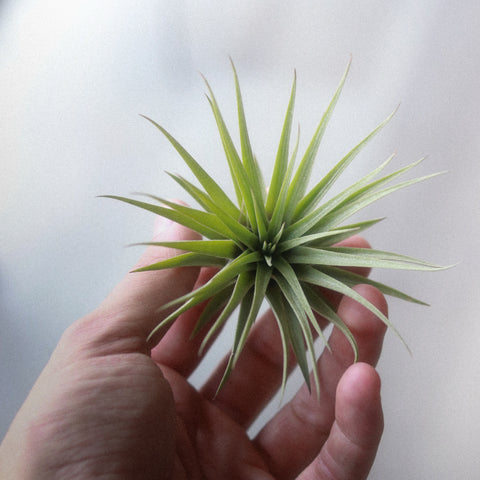
LIGHT
Most air plants are native to very tropical, bright environments. They require a lot of bright light!
These plants will do best in or near a window; preferably east or west facing (although some can tolerate a bit of direct sunlight, in which case a south facing window is ideal). If these conditions cannot be achieved with natural light, introducing artificial light (a grow light) is recommended.
WATER
Air plants (Tillandsia) absorb all their water through little cup-like hairs on their leaves! These are called trichomes. In general, the more trichomes a plant has, the less it needs to be watered due to the amount of water absorption.
In order to ensure your plant is receiving enough water, we recommend the soaking method. Fill a bowl or sink with room temperature water and let your air plant float around for about 30 minutes ONCE A WEEK. The number one cause of death for an air plant is over watering. This happens when water gets trapped inside the plant and rots it from the inside out. To avoid this, place your plant upside down on a towel directly after watering to let your plant dry.
PET SAFETY
Although tillandsia are generally considered non-toxic to pets, we do advise caution. Air plants can be seen as a toy to many pets (especially cats) and can be a choking hazard if found by your furry friend.
FOR A DETAILED LIST OF TOXIC PLANTS, VISIT THE LINK BELOW.
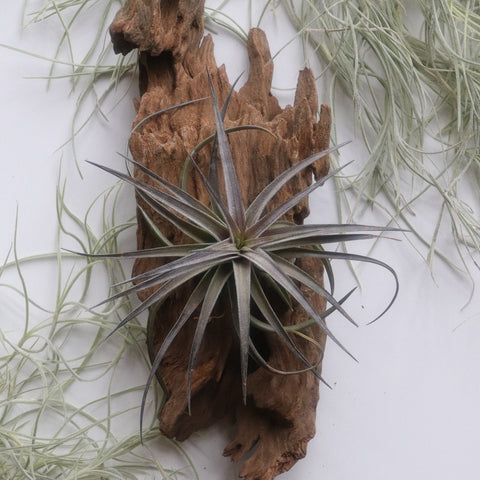
Aeranthos Purple are know for their sharp appearance and purple hue.
Watering Your Aeranthos Purple:
Tillandsia aeranthos purple thrive on regular watering due to its natural habitat in humid environments. To maintain its health soak in room-temperature water for about 20-30 minutes once a week can help provide hydration. After soaking, gently shake off excess water and allow the plant to dry upside down in a well-ventilated area to prevent rot. In drier environments or during hotter months, you might need to increase the frequency of soaking.
Light Requirements for Aeranthos Purple:
Proper lighting is crucial for the well-being of Tillandsia aeranthos purple. It prefers bright, indirect sunlight to thrive. Place your air plant near a window where it can receive filtered light, or under fluorescent grow light if natural light is insufficient. Avoid direct sunlight, especially during the peak afternoon hours, as it can cause the plant to dry out and become damaged. A few hours of direct morning Iight is safe and can help your plant maintain its purple hue. A position within a few feet of a bright window with sheer curtains can provide the ideal lighting conditions. Rotate the plant occasionally to ensure even light exposure and balanced growth.
Watering Your Brachycaulos:
Brachycaulos thrive in a habitat that mimics its native environments of Central and South America. To water this air plant effectively, immerse it in room temperature water for about 20-30 minutes once a week. After soaking, shake off excess water and ensure it dries completely within 4 hours to prevent rot. In drier climates, misting between soakings can provide supplementary hydration, but avoid leaving water to pool in its central rosette, as this can cause rot.
Light Requirements for Brachycaulos:
Being epiphytic, Tillandsia Brachycaulos thrive in bright, indirect light. Place it near a window where it can receive filtered sunlight or under artificial grow lights. Direct sunlight, especially during the hottest parts of the day, can scorch its leaves, so providing shade during peak hours is essential. Some direct morning sun is safe and can air in giving your plant a red hue. Rotating its position periodically ensures even exposure to light, promoting balanced growth and vibrant coloration.
Watering Your Bulbosa:
Bulbosa, known for their unique bulbous bases and curly, green leaves, require regular watering to thrive. To water your Bulbosa, submerge it in room temperature water for about 20-30 minutes once a week. In more humid environments, you might reduce this to once every two weeks, while in drier conditions, you might need to increase it to twice a week. After soaking, gently shake off excess water and place the plant upside down on a towel for a few hours to ensure it dries completely. This prevents water from accumulating in the bulbous base, which can lead to rot.
Light Requirements for Bulbosa:
Bulbosa thrive in bright, indirect light. They should be placed in a location where they receive plenty of filtered sunlight, such as near a north or east-facing window. Direct sunlight can be too intense and may cause the leaves to dry out or scorch, so if you place them near a south or west-facing window, use a sheer curtain to diffuse the light. Ensure they get about 6-8 hours of light daily to promote healthy growth and vibrant foliage. If natural light is insufficient, consider using a grow light to supplement their lighting needs.
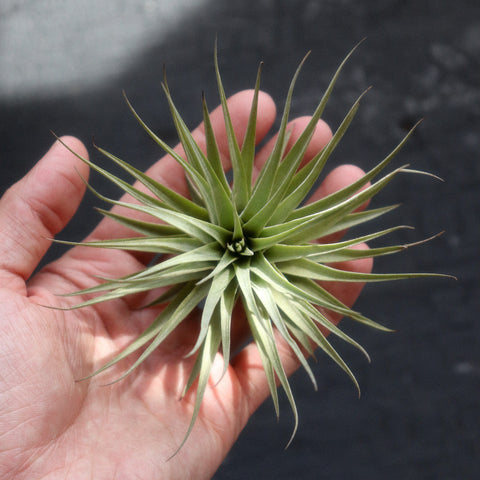
Espinosae are easily recognizable by their brittle leaves and concentric form.
Watering Your Espinosae:
Tillandsia Espinosae, like other members of the Tillandsia genus, thrive in environments with good air circulation and moderate humidity. When it comes to watering, these air plants require a gentle touch. Submerge them in room temperature water for about 20-30 minutes once a week, then shake off excess water and allow them to dry completely upside down. Misting can be beneficial between soakings, especially in drier climates.
Light Requirements for Espinosae:
Tillandsia Espinosae appreciate bright, indirect light. Place them near a window where they can receive filtered sunlight for a few hours each day. Avoid direct sunlight, especially during the hottest parts of the day, as it can scorch the delicate leaves. If natural light is insufficient, supplement with a grow light designed for indoor plants to ensure proper photosynthesis and growth.
Watering Your Gardneri:
To ensure its health and vitality, proper watering is essential. To water effectively, immerse the plant in room temperature water for 20-30 minutes once a week to provide a deep hydration. After watering, shake off excess water and allow the plant to dry completely before placing it back in its display area. Misting this plant between soaks can help maintain moisture and keep your Gardneri from drying out.
Light Requirements for Gardneri:
In terms of light requirements, Tillandsia Garneri thrives in bright, indirect sunlight. Place it near a window where it can receive ample natural light without being exposed to direct sunlight for extended periods, as this can cause the leaves to burn. Fluorescent or artificial grow lights can also provide the necessary light intensity for healthy growth. Regularly rotating the plant ensures even light exposure, promoting balanced growth and vibrant foliage.
Watering your Harrisii:
Tillandsia harrisii, like many air plants, thrive in bright, indirect light. It can tolerate some direct sunlight, especially in the morning or late afternoon, but it's essential to avoid prolonged exposure to harsh midday sun, which can cause the leaves to scorch. If natural light is insufficient, fluorescent or grow lights can be used to provide the necessary illumination.
Light Requirements for Harrisii:
Proper watering is crucial for the health of Tillandsia harrisii. This air plant should be watered once or twice a week, depending on the humidity and temperature of its environment. To water, submerge the plant in room-temperature water for about 20-30 minutes. After soaking, gently shake off excess water and allow the plant to dry upside down within 4 hours to prevent rot. In high-humidity areas, misting the plant lightly may be sufficient, while in drier climates, more frequent soakings may be necessary. Ensure good air circulation around the plant to aid in drying and prevent fungal issues.
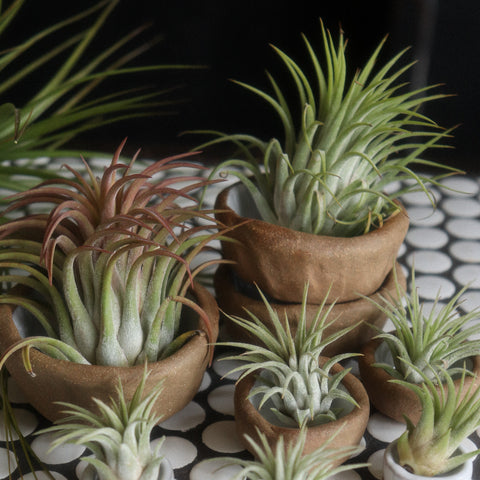
Ionantha are one of the most common, recognizable air plants and they are great for beginners!
Watering Your Ionantha:
To keep your Ionantha healthy and thriving, submerge the plant in water for about 20-30 minutes once a week, making sure to shake off any excess water to prevent rot. Adjust the frequency of watering based on the humidity levels in your environment; in drier conditions, more frequent watering might be necessary. Always allow your Ionantha to dry completely within 4 hours of watering to avoid prolonged dampness, which can lead to rot.
Light Requirements for Ionantha:
Ionantha plants thrive in bright, indirect light. Place them near a window where they can receive filtered sunlight, as direct sunlight can cause their leaves to scorch. If natural light is insufficient, you can supplement with fluorescent or LED grow lights, keeping them on for about 12 hours a day. Ensure the light source is not too close to avoid overheating the plant. Proper lighting will not only keep your Ionantha vibrant but also encourage blooming and overall growth.
Watering Your Juncea:
Watering Tillandsia Juncea requires a balance to mimic its natural habitat. The best method is to soak it in water for about 20-30 minutes once a week. After soaking, gently shake off excess water and allow the plant to dry completely within 4 hours to prevent rot. In humid environments, less frequent watering may be necessary, while in drier conditions, more frequent soaking might be needed.
Light Requirements for Juncea:
Tillandsia Juncea thrive in bright, indirect light. It is well-suited to environments where it can receive filtered sunlight, such as near a south or east-facing window. Direct sunlight can be too harsh and may cause the leaves to scorch, so it’s important to provide some protection, such as sheer curtains or positioning it slightly away from the window. If natural light is insufficient, fluorescent or LED grow lights can be used to supplement, ensuring the plant gets the light it needs to grow and flourish.
Watering Your Medusae:
Tillandsia medusae, like other air plants, absorbs water through its leaves rather than roots. To keep it hydrated, soak it in room temperature water for 20-30 minutes once a week. After soaking, shake off any excess water and let the plant dry upside down in a well-ventilated area to prevent rot. Adjust watering frequency based on your environment; in drier climates, more frequent soaking may be necessary.
Light Requirements for Medusae:
Tillandsia medusae thrives in bright, indirect light. Place near a window where it can receive filtered sunlight, or provide artificial light if natural light is insufficient. Direct sunlight can be too intense and may cause the leaves to scorch, so avoid placing it in a spot where it will be exposed to harsh rays. A spot that receives morning sunlight or is shaded by a sheer curtain is ideal for this unique air plant.
Watering Your Plagiotropica:
To water Tillandsia plagiotropica, submerge the plant in room temperature water for 20-30 minutes once a week, then shake off excess water and allow it to dry upside down in a well-ventilated area to ensure the plant is drying completely and prevent rot. Misting can be beneficial between soakings, especially in drier climates.
Light Requirements for Plagiotropica:
Place Tillandsia Plagiotropica in bright, indirect sunlight for optimal growth. Avoid placing it in direct sunlight for extended periods, as this can lead to leaf burn. A location near a east or west facing window or under grow lights works well. If natural light is insufficient, supplement with a grow light designed for indoor plants to ensure proper photosynthesis and growth.
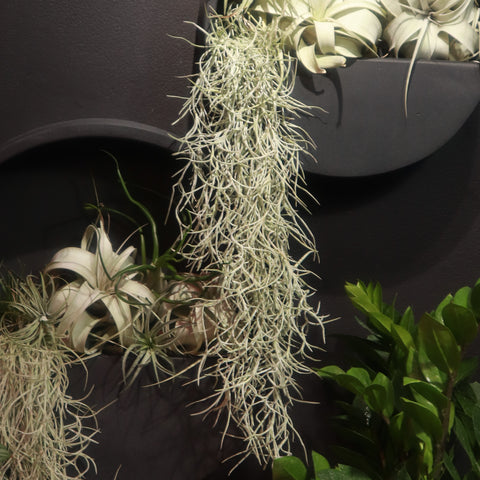
Spanish moss can be intimidating! Don't worry though, caring for it is very similar to caring for any other air plant!
Watering Your Spanish Moss:
Spanish moss thrives in environments with high humidity. To keep it healthy, soaking the moss in water for 20-30 minutes once a week can help maintain its moisture levels, followed by allowing it to air dry thoroughly. If your worried about your moss being in a rather dry environment, mist your moss every few days to ensure it stays moist, but be cautious not to overwater, as this can lead to rot.
Light Requirements for Spanish Moss:
Light requirements are relatively flexible, but it prefers bright, indirect light. Direct sunlight, especially in hot climates, can scorch the delicate foliage, so it's best to place it in a spot where it can receive filtered light or partial shade. Indoors, a location near a window with sheer curtains or in a well-lit room with plenty of ambient light is ideal. While Spanish moss can tolerate lower light conditions, growth may slow, and the moss might not be as vibrant. Adjust its position as needed to ensure it receives the right balance of light for optimal health. An east or west facing window is preferred. If placed near a south facing window, use sheer curtains to diffuse the light or keep the moss a few feet away from the window.
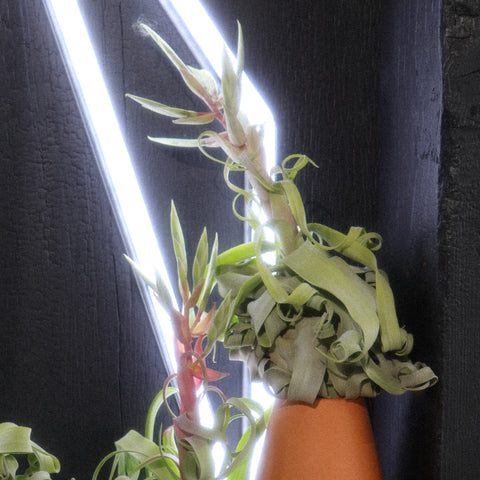
Streptophylla are a part of a group of air plants referred to as "Xeric", meaning they are typically found in drier, arid climates amongst cacti and rocks. They get their muted, green color from the abundance of "trichomes" on their surface. Trichomes help air plants collect the moisture and nutrients they need to survive!
Watering Your Streptophylla:
When it comes to watering this charming plant, moderation is key. Submerge the plant in room temperature water for about 20-30 minutes every one to two weeks. After soaking, shake off excess water and allow it to dry upside down to prevent water from pooling at its base, which can lead to rot. Ensure good air circulation around the plant to aid in drying. Over-watering can be detrimental to the health of Tillandsia Streptophylla, so always err on the side of caution.
Light Requirements for Streptophylla:
In terms of light requirements, Tillandsia Streptophylla thrive in bright, indirect light. Place it near a window where it can receive ample natural light without direct exposure to harsh sunlight, which can scorch its delicate foliage. Some direct morning sun is safe and will aid in giving your plant a soft, pink hue. If natural light is limited, supplement with artificial grow lights designed for indoor plants to maintain its vibrant green hue and promote healthy growth. Striking a balance between light and shade will ensure optimal conditions for Tillandsia Streptophylla to flourish.
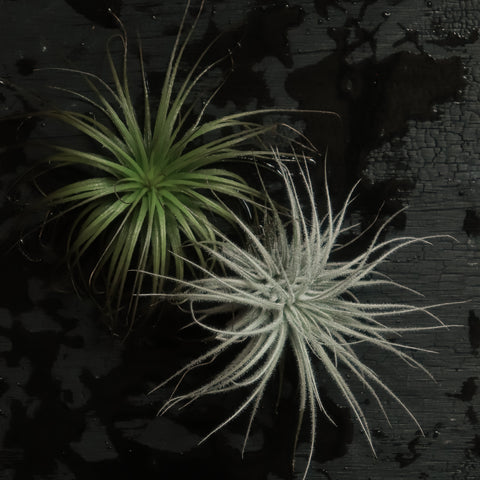
Like Xerographica, Tillandsia Tectorum are native to a more arid climate amongst cacti and succulents. Caring for Tectorum is similar to any other air plant but they do have some differences.
Watering Your Tectorum:
Tectorum thrive with minimal watering but requires consistent moisture to stay healthy. Dunk your Tectorum in water two to three times a week, ensuring that the plant gets enough moisture without becoming waterlogged. For a more thorough watering, you can submerge the plant in water for about 20-30 minutes once every two weeks. After soaking, shake off any excess water and allow the plant to dry completely before returning it to its display. Be cautious not to let water sit in the crevices of the plant, as this can lead to rot.
Tectorum prefer bright, indirect light to thrive. Place your Tectorum in a spot where it receives filtered sunlight, such as near a window with sheer curtains or in a well-lit room with indirect exposure. These plants can handle a few hours of direct morning sun but avoid placing the plant in direct sunlight for extended periods, as this can cause the leaves to dry out and burn. If natural light is insufficient, you can supplement with fluorescent or LED grow lights, keeping the lights on for about 12 hours a day to mimic natural daylight conditions.
Watering Your Veluntina:
Proper watering is crucial for the health of Tillandsia veluntina. To keep it hydrated, soak the plant in a bowl of water for 20-30 minutes once a week, shaking off excess water afterward and allowing to dry upside down to prevent rot. Ensure the plant dries within a few hours after watering to avoid prolonged moisture on its leaves, which can lead to fungal issues.
Light Requirements for Veluntina:
Tillandsia Veluntina thrive in bright, indirect light. While it can tolerate some direct sunlight, too much exposure can scorch its leaves, so it's best to place it in a spot where it will receive filtered light, such as near an east or west-facing window. Providing the right amount of light will help your Tillandsia veluntina maintain its vibrant color and overall health.
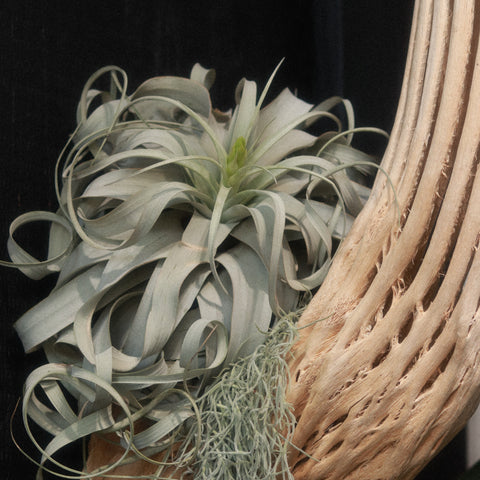
Xerographica are one of many air plants that actually grow in more arid climates rather than tropical! Because Xerographica are naturally used to drier climates, these plants can can take a bit more direct sunlight and less water.
Watering Your Xerographica:
The Tillandsia xerographica, often called the "King of Air Plants," requires careful watering to thrive. To water your xerographica, submerge it in room temperature water for about 20-30 minutes once every two to three weeks. After soaking, gently shake off any excess water and allow the plant to dry upside down in a well-ventilated area to prevent rot. Allowing it to dry upside down is essential because of the plant's deep crevasses that tend to trap water in. In between waterings, misting the leaves lightly once a week can help maintain its moisture levels, especially in dry climates or during hot weather.
Light Requirements for Xerographica:
Xerographica thrive in bright, indirect light. Place it near a window where it can receive plenty of filtered sunlight, but avoid direct sun exposure, which can scorch its leaves. A few hours of direct morning sun is okay and might help your plant blush a soft, pink color. If natural light is insufficient, fluorescent lights can supplement its needs, providing about 12 hours of light per day. Ideal conditions mimic its native tropical environments, with good airflow and temperatures ranging between 50°F and 90°F (10°C to 32°C). Avoid placing it in dark or overly shaded areas, as insufficient light can hinder its growth and overall health.